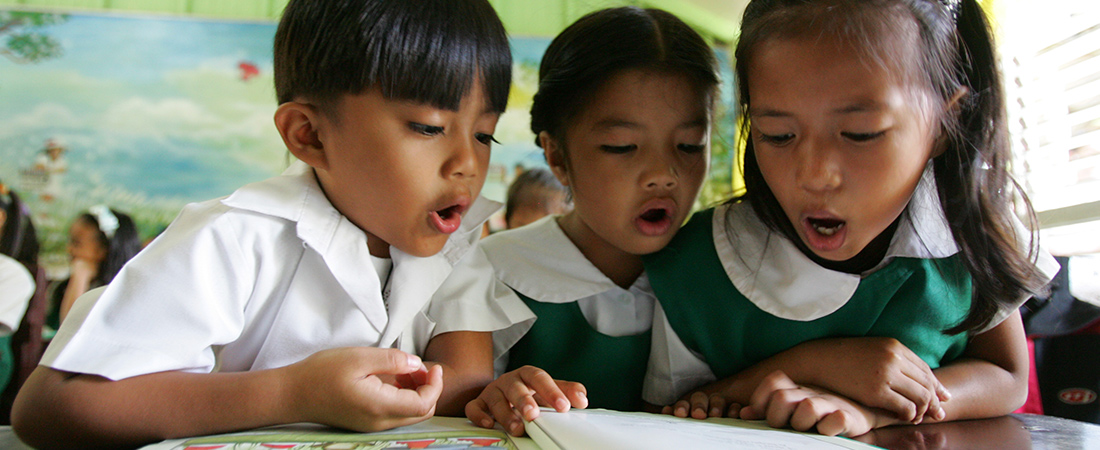To Improve Literacy, Examine the Book Supply Chain

Learning to read is an active process. And for young learners, books are the catalyst for reading fluency and enjoyment.
But in too many communities around the world, children do not have sufficient access to age-appropriate reading materials, either at home or in school. This deficit of reading materials stunts their literacy development and has long-term educational, economic, and societal ramifications.
Through their work with USAID's Global Book Alliance In Action project (GBAIA) EDC’s Simon James and Tracy Cordner are involved in a global effort to improve young readers’ access to books. Specifically, they are focused on the book supply chain—the process by which books are planned, written, produced, distributed, and used. Below, James and Cordner discuss what they have learned about children’s uneven access to books in emerging economies, and they detail some promising practices to promote reading and literacy.
Q. We shouldn’t take access to children’s books for granted, should we?
James: No, certainly not. In the U.S. and other developed countries, you can go into a local bookshop and pick up multiple books that a five year-old may enjoy reading. But in many developing countries, finding age-appropriate books for children is much more difficult. Libraries and bookstores are rare. And where books are available for sale, they are often too expensive for families. Often, the local school is the only place that has books, but those books may be old, in poor shape, or uninteresting to young readers. I’ve visited some schools where all the books are kept locked in cabinets because they are considered too valuable to lend out to learners.
Q. Young children can’t learn to read if they do not have books. How does the book supply chain affect the availability of children’s books in emerging economies?
James: Book publishing—especially educational book publishing—is a complex process with a lot of actors, and it varies by country. The market forces themselves can make it very difficult for children’s books to be published. In countries with many local or regional languages, there is no mass market for any individual book—the demand is very specific. And if you don’t have anybody to write the book, or to publish it once it is complete, then you simply have no books. You also have to consider the cost of paper, the quality and cost of the printing, and the associated taxes. Sometimes the cost of producing and distributing the books far outstrips any potential market for it.
Cordner: As part of our work with the Global Book Alliance, Simon and I have been conducting supply chain analyses in Malawi, Cambodia, Zambia, and Jordan. What we have seen is that ministries of education are usually in charge of publishing textbooks, but that they don’t often prioritize grade-level-appropriate reading materials. In Cambodia, for example, the government issues textbooks to schools, but does not currently provide decodable books or leveled readers for young children. The upshot is that children in primary school do not have any access to books that are at their reading level, even at school.
Q. So what kinds of books are children reading in these countries?
James: In Cambodia, there are all sorts of books available, including those published by Cambodian companies as well as those from international publishers in English. Although there are some local publishers producing high-quality materials in Khmer, a lot of supplementary reading materials tend not to be high quality. One thing we saw frequently was that books for young children had a large amount of text on a page—in addition to illustrations. This is not very amenable to helping young readers learn to read!
Cordner: But having a lot of words on a page was actually seen as a good thing there. Parents felt that the best books had the most words—so buying a picture book with only a few words was seen as a waste of money, even though developmentally that is exactly what children need.
Q. How has COVID-19 made this situation worse?
James: One of the big issues is the schools have closed down. Schools are often the only source of books in communities. If they are shut down, then kids don’t have access to books, and they don’t read. We worry that staying home for an extended period of time will threaten literacy gains. Tax revenue is also going to fall everywhere because of the pandemic. This means that ministries will have less money, and may therefore spend even less on books than they already do.
Q. Delivering books to children is always difficult—and even more so in the middle of a pandemic. What is GBAIA doing to promote reading and literacy in emerging economies?
Cordner: This past spring, we helped organize a “translation sprint,” where 1,200 volunteers translated 4,000 books into languages where there was a need for books. Many of those books are now available for free on the Global Digital Library, where they can be read on phones or computers, or downloaded for printing, either privately or commercially. We also collaborated around interactive audio instruction lessons from EDC and other USAID partners to make those available on the Global Digital Radio website. Those programs were designed and created for use in schools, but parents and caregivers can use them to support children’s literacy while schools are closed. So if a family or a community has access to the Internet, then there are many high-quality resources available in many languages, some of which have been underserved for a long time.
Q. Are there any promising practices that you think you can take away from this time? Certainly the issue of children not having access to sufficient appropriate books is not going to be solved anytime soon.
Cordner: Simon was talking about the pitfalls of the book supply chain earlier. Effective development and distribution of physical books for children is dependent on a wide variety of factors. Government ministers must have a plan to develop, produce, and distribute books to schools across their country. But these steps don’t exist yet in a coordinated fashion in many countries. However, a lot of families now have access to a mobile phone, or there is community access to the Internet. So I think the work that we have been doing with the GDL is important, because it allows us to create so many books so rapidly in multiple languages—something that isn’t possible through the regular supply chain.
James: Going the digital route provides opportunities for rapidly providing appropriate materials to large numbers of learners. But children still need actual books in schools and at home if they are to learn to read. Our partners at USAID say that books need to be “available, accessible, appropriate, and affordable.” I think that’s right. We have seen an abundance of local talent in the countries we have visited. So the first step is to harness that talent to write, illustrate, and publish stories for young readers. Then we have to work with governments, communities and parents to provide those books to the children. If GBAIA can help improve this process, then it will have made a significant difference.

